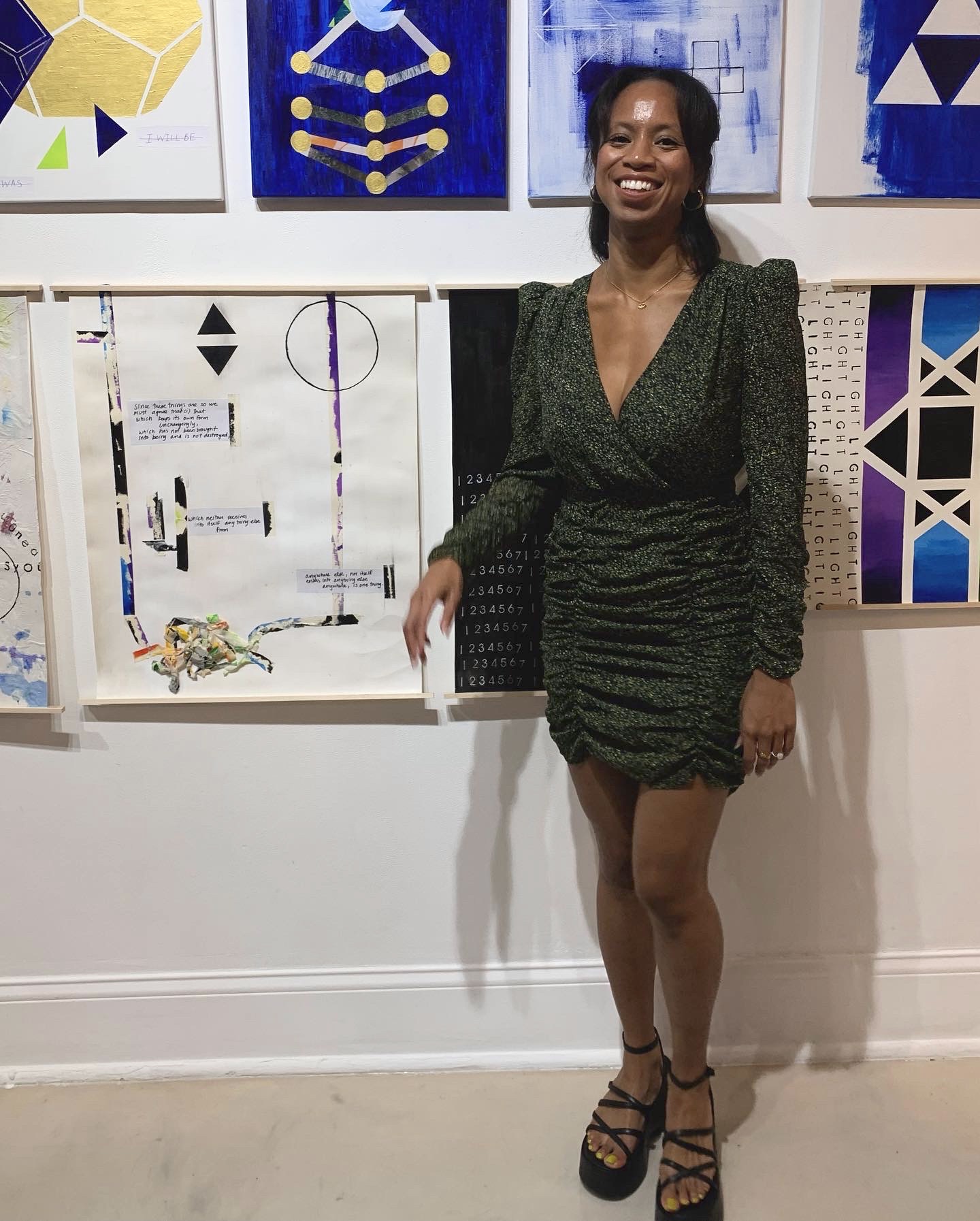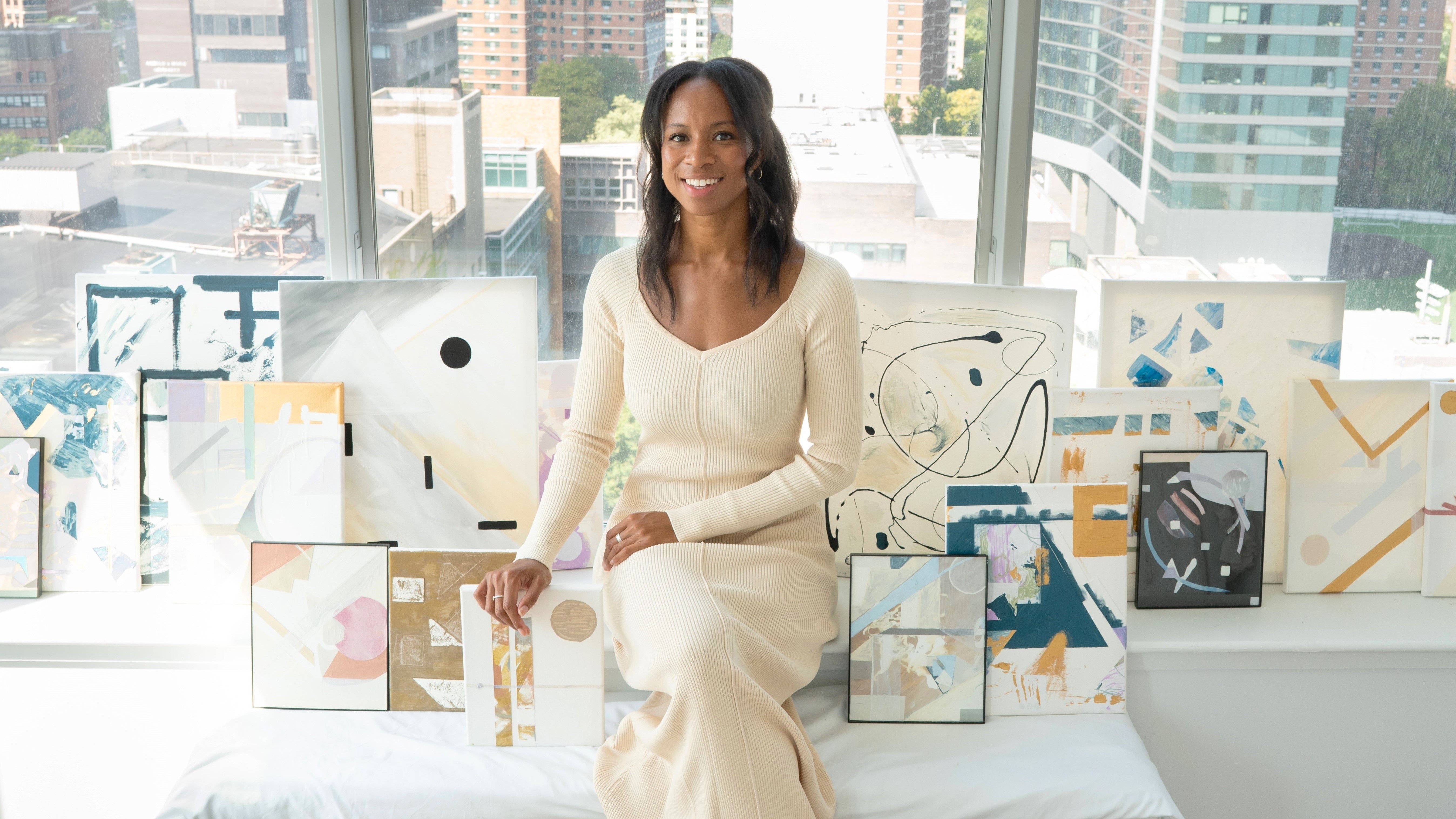The following story appeared in the January/February 2024 issue of SKATING magazine. Click here to purchase a subscription to SKATING magazine.
By Lois Elfman
As Kristine Musademba, 2005 U.S. intermediate champion, progressed in skating — a journey that included competing at the U.S. Figure Skating Championships at the juvenile, intermediate, novice, junior and senior levels — she began to value the connection with the audience and the artistic expression. Today, her artistry is expressed through painting and collage. Exploring colors and concepts is exhilarating, and she savors how a finished piece can be interpreted in many different ways.
Last fall, her work was part of a group show titled Camp Underground; it included visual artists, musical artists and other creators. It was put together by two women focused on elevating the work of BIPOC creators, artists, musicians and entrepreneurs. It took place in Brooklyn, New York, where Musademba, 31, has made her home for several years.
“I showcased a number of creations that were acrylic and collage pieces as well as some poetry and some interactive art,” Musademba said. “It was my first ever public show where I was selected to be a part. It was really wonderful. I got to share details about my artwork series, titled “sacred series (1),” which was based on representations and themes of sacred geometry.”
She defines sacred geometry as abstract and sacred geometric figures used as tools to represent the foundational elements of being and creation.
Musademba is constantly inspired by the concepts of love, community and the celebration of individuality and uniqueness. The series showcased at Camp Underground was meant to explore the journey from logical, external-based experiences as humans toward a more general sense of being, tied to the nature of consciousness soul.
“I can actually carry millions of different qualities … and I don’t need to limit myself,” she said. “My most recent series is consciously intentional about geometric abstract work and that intentionality is something quite new for me. I’ve sold paintings at markets and in my neighborhood. The abstract approach to art feels very much like a novel way to communicate my own unique expression.”
She has always loved drawing and painting since she was a child, noting that if she hadn’t gotten into skating, she probably would have seriously pursued art. There was some crossover, noting she designed a couple of her skating competition dresses.
Her beginning in skating was fairly casual — trips to the rink with her best friend. In time, people saw her potential and encouraged her to pursue the sport. At age 7, Musademba, who grew up in Maryland and trained at Cabin John Ice Rink, began to take it seriously.
“I stepped into this identity as an athlete,” she said. “It led me to do research on how great athletes practice and what their mindset is. I was looking to those athletes who were at the top of their game, and I was seeking to sort of emulate that and also take on those characteristics.”
Discipline and determination became key. She also loved the feeling of skating, and she appreciated how she was progressing.
Musademba won the silver medal in novice ladies at the 2007 U.S. Championships and the pewter medal in junior ladies the following season. Those results led to international assignments. She won gold medals at ISU Junior Grand Prix competitions in France, Spain and the U.S., and twice earned trips to the Junior Grand Prix Final.
“International competition is another one of those pivotal moments for an athlete where your world expands even further,” she said. “I took back with me not only experiences from the physical environment of those spaces and cultures, but also the interaction with the athletes.”

She competed at the U.S. Championships twice at the senior level. After a 15th–place finish in 2011, she decided it was time to leave competitive skating and head to college. Musademba chose Columbia University in New York City.
“It was both challenging, yet exciting,” she recalled. “I was in this space of letting go of the identity of a competitive figure skater, yet using so much of the positive character traits I built through the sport to help myself in an academically rigorous environment.”
Attending college in New York City provided access to all the city has to offer — diverse communities, arts, culture and history. It was a time of exploration and adventure. She did internships at music labels and wrote music, DJ'ed in the East Village, acted, tried speed skating, and joined the campus newspaper (Columbia Daily Spectator), a sketch group and a sorority. She graduated in 2015 and has remained in the city.
Her career has spanned across the legal, business consulting and finance fields, and she recently began a new position as a manager on the finance team for an impact-focused renewable energy investor and project developer.
“I’m excited to be involved in the impact investment space given its intention to direct capital in the name of sustainability and equity — both things that I think are critically important in the world we live in today,” Musademba said. “I believe this work supports progress toward a cleaner, safer and more just environment for all living beings.”
Musademba is biracial — her mother is from the Philippines and her father from Zimbabwe. She did not focus much on her diverse heritage when she was skating, feeling there wasn’t really any venue for her to do that.
“I was focused on performance and training, but I, of course, had moments of feeling different than the majority of my peers from a visual standpoint,” she said. “I often received messaging from society that I should be bucketed into a certain category. Experiencing this dynamic of categorization in the world has only solidified how unnecessary it is to place people into categories based solely on how they look, and, most importantly, how beneficial it is for people to seek to understand who someone is by their heart, not just what one sees on the outside.”
She recently met 1979 World pairs champion Tai Babilonia at an Ice Theatre of New York event, and the two spent time discussing their similar heritage. Babilonia is Black and Filipina as well as Hopi Native American. At that event, Musademba also connected with Diversify Ice founder Joel Savary, who invited her to take part in a board meeting.
“I see my involvement in [Diversify Ice] as another opportunity to increase equitable outcomes and opportunities for underrepresented skaters and communities,” Musademba said. “Skating helped me discover so much about myself, including my strength and my power to create, achieve and make positive and amazing things happen. I’m looking forward to taking those lessons into every aspect of my life.”
She still skates a bit, mostly at an outdoor rink in Brooklyn. When she gets on the ice, it reminds her of how unique and special the feeling of figure skating is.
When Musademba looks back on some of her fondest skating memories, a highlight is winning the intermediate title.
“It was my first big win on a national stage, and it was one of those moments where I just let everything go,” she said. “It was also a pivotal moment for me in my competitive career, allowing me to really recognize and step into my strength as a skater and place in the skating world.
“Another would be skating a clean short program to ‘Clair de lune’ at the Junior Grand Prix in Lake Placid [2009]. Clair de lune has been my favorite piece of music to skate to, and I loved the feeling and choreography of that program. It felt like hope, and I felt so beautiful and calm skating to it.”
U.S. Figure Skating is proud to celebrate our diverse membership. Click here to share your story with us for a chance to be featured on U.S. Figure Skating’s website or social media channels.


